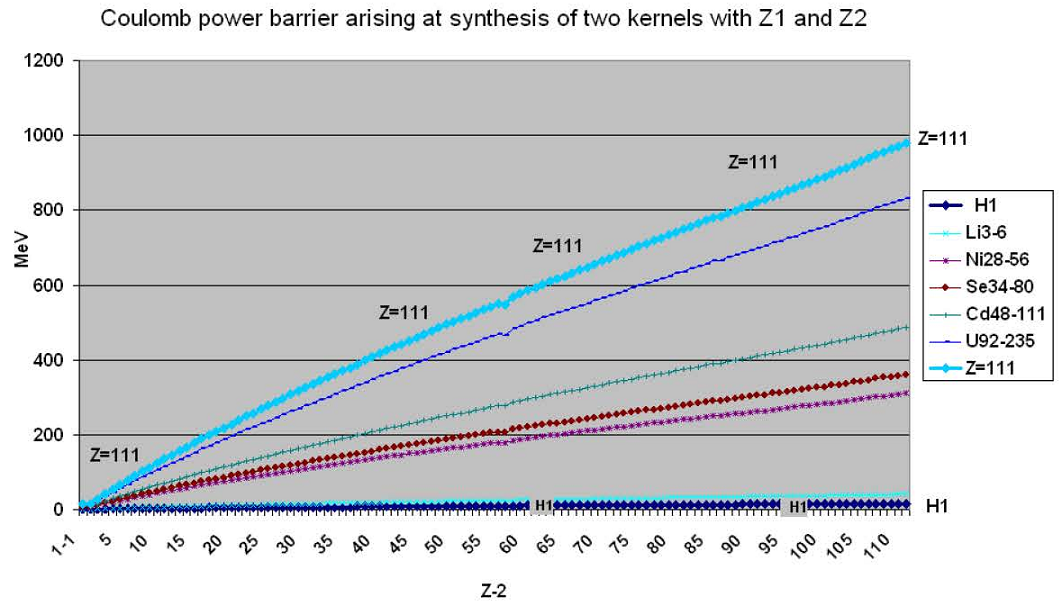«The analytical astrophysics»
2. Physical bases of «analytical astrophysics»
The physical basis of modern astrophysics is «the theoretical physics» and «the quantum mechanics», theories which have become outdated and erroneous. Today, the scientific research material that was saved up demands more serious processing and an analysis. In order to understand the physics of processes occurring in space, it is necessary for us to analyze the physical processes which occur in terrestrial conditions and to project them on space objects. We shall consider some physical processes which will help us to look at physical processes in a space in a new way. There are many mistakes and errors in the modern astrophysics, and we shall confront them in this work and will be obligated to analyze and deny them. One of such mistakes is the opinion of scientists about the impossibility of synthesis of kernels of heavy atoms in stars.
2.1. A power barrier of kernels
In the beginning of the twentieth century, Eddington has stated a hypothesis, about allocation of energy in stars, due to the synthesis of kernels by atom of hydrogen in kernels of atoms of helium. Since then there is a dispute among the scientists, about the possibility of synthesis in bowels of stars, kernels of higher weights, than at helium. By theoretical calculations, the temperatures inside of a star are hardly sufficient for synthesis of easy kernels, but on practice, we see the opposite phenomenon. In a chemical compound of stars including the Sun, heavy elements are being found out. The existence of heavy elements in the structure of planets and the Earth speaks about their synthesis in stars. And if not in stars, then, where?! The history of opening of the 99-th (Es) and the 100-th (Fm) elements of a periodic table during the test for «hydrogen» bomb, speaks unequivocally about the possibility of synthesis of heavy elements in stars. If the explosion of a «hydrogen» bomb has sufficed for synthesis of 99-th (Es) and 100-th (Fm) elements, than in stars there should be the conditions for synthesis of heavy kernels, since the capacity of energy created in a star is higher than a bomb’s. What conditions are necessary for synthesis of kernels? The basic obstacle for nuclear interactions are coulombforces of pushing away or coulombbarrier which kernels have to overcome at the synthesis. The «height» of coulombbarrier power can be defined by the formula:
where z1 and z2 — amount of protons in the nucleus participating in the synthesis,
e — a single charge equal to the value of the electron charge (plus sign),
ε0— the dielectric constant for vacuum,
R — distance by which to reconcile the two nuclei for the synthesis
R=R1+R2, (2.2)
R1 and R2 — the radii of the nuclei participating in the synthesis.
The radius of the nucleus depending the number of nuclides in it — the numbers A: Rj ~ Aj
where Rj — radius of the nucleus j,
Aj — the number of nuclides in the nucleus j.
The radius of the nucleus varies from 1.2 . Aj1/ 3 to 1.4 . Aj1/ 3, that is,
Rj = (1.2 ~ 1.4) . Aj1/ 3, fm (2.3)
Depending on what the value of Rj is taken into account, formula (2.1) takes the form:
We receive Rj = 1.4 . Aj1/3, fm (2.5)
But in the case of participation in the synthesis of a proton or hydrogen nucleus with
Aj = 1, Rj is set to:
In this case the formula (2.4) will change a little. Considering the formula (2.5) formula (2.4) will become:
With the participation of a proton in synthesis the formula (2.4) will become:
— In case of when the proton doesn’t move, and the kernel with z2 and A2 flies:
— In case of when the proton flies, and the kernel with z1 and A1 is not mobile:
— In case of participation of two protons in synthesis the formula (2.4) will become:
 (2.10)
(2.10)
Synthesis of two protons gives the following reaction:
![]()
We shall consider this variant for analytical comparison since it is considered as one of the basic variants of synthesis existing in stars.
Let’s consider changes coulombpower barrier at synthesis of two kernels with different values z and A, by formulas (2.4), (2.7), (2.8), (2.9) and (2.10).
Schedule№G-2.1 is constructed under these formulas.
From schedule №G-2.1 it is visible, that the power barrier is increasing with the growth of a charge of a kernel almost linearly. From the calculations of a power barrier it is visible, that the kernels having high kinetic energy can participate in synthesis.
We know that the power threshold of a kernel is less settlement, due to the «tunnel effect». Exact measurements are not presented yet. We shall lean on the characteristics wecalculated, without attaching to figures, and analyzing the dynamics of changes in these characteristics.
Coulomb barrier to reactions Ne, Sn, and Th relative to protons, deuteron and to alpha-particles, is shown in the table №T-2.1.







